
Five ways to know if you're wearing your Colours.
Getting your Colours right is just so important to your Ultimate Image so read today's blog with 5 ways to tell if you do have them right or not.
You have no items in your cart
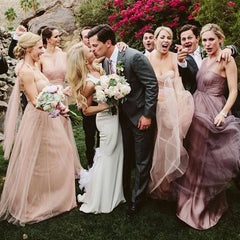
Your wedding will be aesthetically beautiful if you harmonize the whole day around certain colours.
Look at any wedding photo album and note the images that are professional to look at are those with the right colour scheme.
Colour is the key to every image success. Photographers look for light and they look for good colour composition when they create beautiful images.
There are over 2.5 million colours to choose from or more. It's not difficult to choose the wrong colours, so how will you find the right colours for your bridal shots?
Consider colour for the following things-brides outfit, the mother of the bride or groom, the bridal party, shoes, hair colour, make up colours, venue colours and even photographic backdrops.
You can see how so many colours can be in the mix, so here are a few colour tips that will make all the other choices much easier and alleviate some of the stressful decision you need to make.
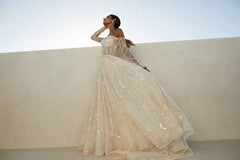
Traditionally bridal colours are softer and more feminine. It's a good look when you're getting married.
You don't want to look back in a few years time and be shocked by some outrageous fashion choices you made.
I'm pleased to see most bridal houses are holding colours like ivory, champagne, beige, silver, silver pinks, rose and soft golds as well as soft pinks and blues to name the most popular tones.

My recommendation for all my brides would be to wear colours that tone into your skin and look soft and natural
Heavy make up, dark eyes, overly shimmery eyes and cheeks and thick unnatural lashes are worn by young women today but this is a fashion that does not look natural and in my opinion very attractive either.
You want a look that is evergreen and proud to be seen for decades to come.
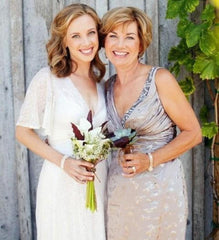
Inkeeping with the bride, mothers can stay on the softer tones theme.
These colours will flatter mature women and give her a more youthful appearance.
Aside from having a colour analysis here are a few ideas. Stick with colours like soft taupes, champagnes, rose gold, soft gold, soft pinks and blues, just to name a few. A professional colour and style analysis will explore all your colour and style choices, so it's a great investment not only for the wedding but for the future as well, if you're one to like to look stylish and ageless.
My Mother of the bride choice is this rose gold dress and shoes and I'll match the jacket in similar tones but with a more structured style than the jacket image here. Perhaps longer sleeves and a thin lapel
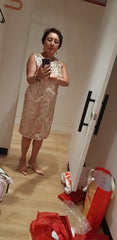
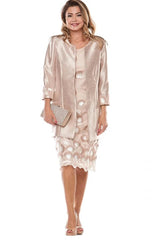
Interestingly enough, wearing the right hair colour can make all the difference to how you will look.
A simple tip is darker hair tones look great lightened a little and blonde tones need to look natural. Sometimes that requires blondes to go a shade darker.
Refer to your colour chart for the optimal hair colours for you.
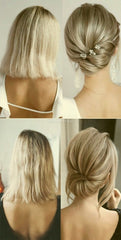
Flowers come in a plethora of shades. Some are dominant colours, some are muted and some have a slightly warm tinge. Find flowers that blend into the colour scheme. Flowers arrangements can also look formal or casual so choose flower shapes that compliment your outfits. Usually softer petals look quiet formal.
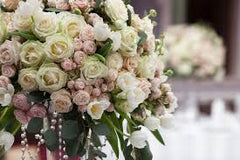
You're venue will ask you for your colour scheme and it's another opportunity to keep the colour theme going.
For example if you're wearing soft beiges and ivory colours, you will want to avoid dominant colours like black and white and primary red for your table settings. Think about colour for everything.
Finally ask the photographer to take photos in the areas that are more natural as well, like the ocean and green spaces. These colours are natural and go beautifully with images of people.
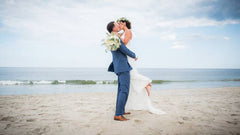
For more information about your colours and style contact Your Colours and Style
Getting your Colours right is just so important to your Ultimate Image so read today's blog with 5 ways to tell if you do have them right or not.

I would describe a neutral colour as one that is quite benign. One that's not screaming for attention, and one that's a base for all of your other amazing colours.
Not everyone feels good in a pink and green outfit for example but they may enjoy wearing perhaps a green top with a neutral like grey.
It's good to start your wardrobe with your neutrals then add your colour in next.
But are all neutrals created equal? Definitely not. Many stylists are firm about having a base of dark cool neutrals like black, pure white, greys and navy’s with a splash of brown thrown in. But those neutrals are only found in the Winter Palette. Black doesn't go with everything, as we've been led to believe. And Winter neutrals don't go with Summer, Spring or Autumn neutrals.
As a colour consultant of 20 years, I have found these ideas to be quiet damaging as a whole to the fashion industry. Using black as a style staple is not useful to your Image picture.

Here's an example of working with a warm Autumn neutral and Black a cool dominant neutral to create a mismatched look.
For a stylish, complete, co-ordinated wardrobe that suits you down to the ground, you need to work with YOUR neutrals only.
The reason being, neutrals from another palette will not look good on you, and also will not go with the other shades or neutrals in your palette.
Some stylists categorize people as neutrals. But I like to call only colours neutral not people.
Every colour is either a Cool Deep or dominant colour,(Winter) a cool muted colour,(Summer) a deep warm colour (Autumn) or a warm bright colour (Spring)
That's it. Every colour on the planet will slot into one of four palettes only. And you will be one of the four palettes as well. No sub colours or flow people in my opinion. Some colours "flow"but not people.

THE COLOUR SWATCH BOOKS FOR THE FOUR SEASONS
Get your colours right. There is Spring, Summer, Autumn or Winter. What season are you and there is no need for any sub seasons.
You will have thousands of colours to choose from that will all look amazing on you.
So what are the four types of neutrals I’m speaking of?
Warm Deep or Autumn neutrals are lovely deep olive greens, rich creams, clays, golden browns, deep apricots, muddied burgundies and pumpkins to name a few as well as rich warm khakis and golds.

The bright Spring neutrals on the other hand are still warm but much lighter than their deep counterparts, so colours like light soft caramels, light creams, warm light browns, tans, peaches and apricots are part of the Spring neutrals.

Moving into the cooler palettes we have the boldness and clarity of the deep Winter colours, black, pure white, all greys, silvers, dark navys and deep deep browns.
Forget burgundy as some may include in the Winter palette. I reserve that for the muted cool neutrals of Summer. The denim which is a winter denim is dark navy blue.

Summer neutrals are cool and soft and muted. Ones like off whites, soft grey, cool taupes, cool beiges, light cool khakis, burgundy and maroons create a nice base and don’t forget your dusty navy’s. Please don’t forget light denim teams best with these colours.

With all this in mind you can see there is a plethora of colours, considered to be neutral.
So once you know your colours, you can stick to the neutrals within your season for best results. Ask your consultant how to incorporate these into your wardrobe.
It’s always best to get professional advice about your colours and be sure the colours actually “fit”with you.
If your not happy with your results after a colour analysis, my advice would be to get a 2nd and sometimes even a 3rd opinion until you get your colours right.
I have had so many clients over the years who have had their colours done incorrectly.
There is a mindfield of systems now so I hope you find a solution that’s right for you.
HOW TO TELL IF YOU HAVE THE RIGHT COLOURS?
Here are a few checkpoints.
You'll look younger and more attractive in your colours
Your hair colour will compliment your colours
3. Your make up will blend into your skin and not sit on top
4. You will have 100’s and 100’s of colours to choose from
5. You will feel at peace in your colours
6. All the clothes in your wardrobe will coordinate
7. You will have heaps of outfits even if you have a small wardrobe (capsule)
8. You’ll always get compliments about what your wearing
9. You'll find it easier to accessorize and mix and match
You’ll look very stylish all the time.
For more information contact Your Colours and Style Sydney
The New Year might just be a good time to revamp your make up

Your Image is not the same without a good face of make up
You could wear the most amazing outfit but if your face is not right the whole thing will look below par
So let’s get down to some great ways to improve your make up with some tried and true tricks to applying your foundation.
Here are my 5 top tips?
Beautiful skin is always the best place to start when applying your make up.
If you apply foundation over dry skin, the foundation will appear dry and flaky. Make sure you have subtle moist skin as your base.
My clients are always asking for a foundation and powder that doesn’t make their face look more lined. Even if you are more mature and have a number of lines and wrinkles, having the right foundations and powders as well as knowing how to apply them will make the face appear less lined and much smoother. Actually it can take years off your appearance.
The first step is prepare your skin. That doesn’t happen overnight. Skin should be looked after from an early age by using the right products and treatments and taking the right care.
Stay out of the sun and wear a sunscreen daily. Have regular facials if you can afford them or have good home care.
Cleanse and moisturise and apply vitamin C serums and retinols so the skin is soft and moist.
Tip no 2. The right colour foundations, powders and concealers.

WRONG COLOUR FOUNDATION
Have you ever noticed foundations that look bad?
The most common problem is the colour. The wrong colour can make the face look heavy and unnatural.
How do you choose the right colours?
Our Colours foundations stick mostly to beige or pink based foundations. Yellow and orange tones have become mainstream and popular but these tend to make the foundation look thick and heavy.
The wrong colours are somewhat better on very young flawless skin, but who has young flawless skin?
The rest of us look better in pink based foundations because skin colour is pink.
If your face is too red try the beige neutral based colours.
To know if the foundation you choose is right for you, apply a tiny streak of foundation on the base of the cheek.
The foundation should be unnoticeable. This is a good colour match for you.
The same apply’s for powders and concealers. Powders are meant to sit on top without changing the colour at all and concealers are meant to conceal, dark areas and spots etc.
Tip no 3. Apply a tiny tiny amount.
Take a close look at your face in the mirror. Can you see the skin isn’t perfectly one colour.
It’s actually quiet spotted or mottled. This is completely normal. Some people have more pigmentation than others and unevenness.
Not to worry. A good foundation will smooth the skin out to more uniformity, as long as it is exactly the right shade for your skin.
The secret is to apply as little of the appropriate foundation as you possibly can. This can be done by applying a small amount with a foundation brush and then buffing it in with a buffer brush or stipple brush.
Tip no 4. Seal with the right powder or not.

A light dusting of wet and dry powder. Medium skin tone
Powder is a personal choice. A lot of mature women are afraid of powder as they think it settles in the lines and wrinkles.
This isn’t the case if you dust lightly over your foundation and buff it in and also if you have the right colour powder as well. It needs to be somewhat translucent as you don’t want to change the shade of your foundation.
If you prefer a dewier look you can skip the powder, but remember powder is a good setting agent, it dampens shine and allows your make up to be more long lasting.
Tip no 5. The right concealer.

Concealer #500 applied as eyebase and inside eye area and part of the under eye.
Light porcelain skin colour
Your foundation, powder and concealer trio is the whole base for your make up.
First prep, then moisturise, apply foundation, then powder and finish with concealer for a good palette to work with.
All your colour and definition can be made once you have a good clean face to start with. Begin with the wrong foundation and your make up is all downhill from there.
 Light skin tone above. Deep skin tone below.
Light skin tone above. Deep skin tone below.
If you would like a free make up appraisal contact Your Colours and Style.


